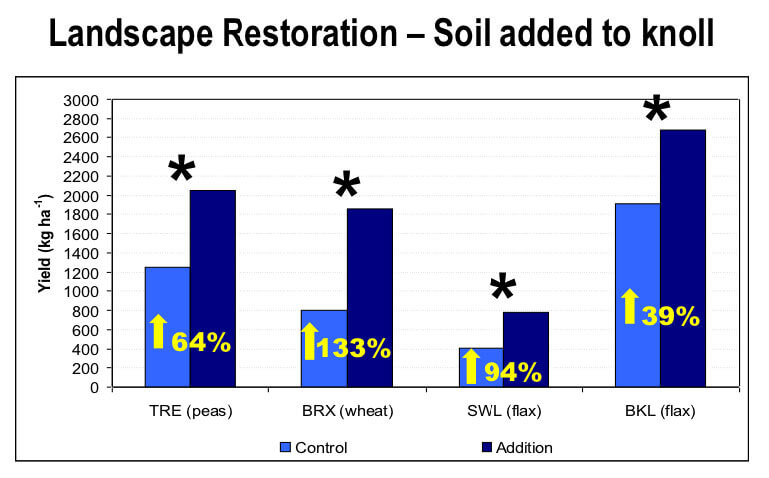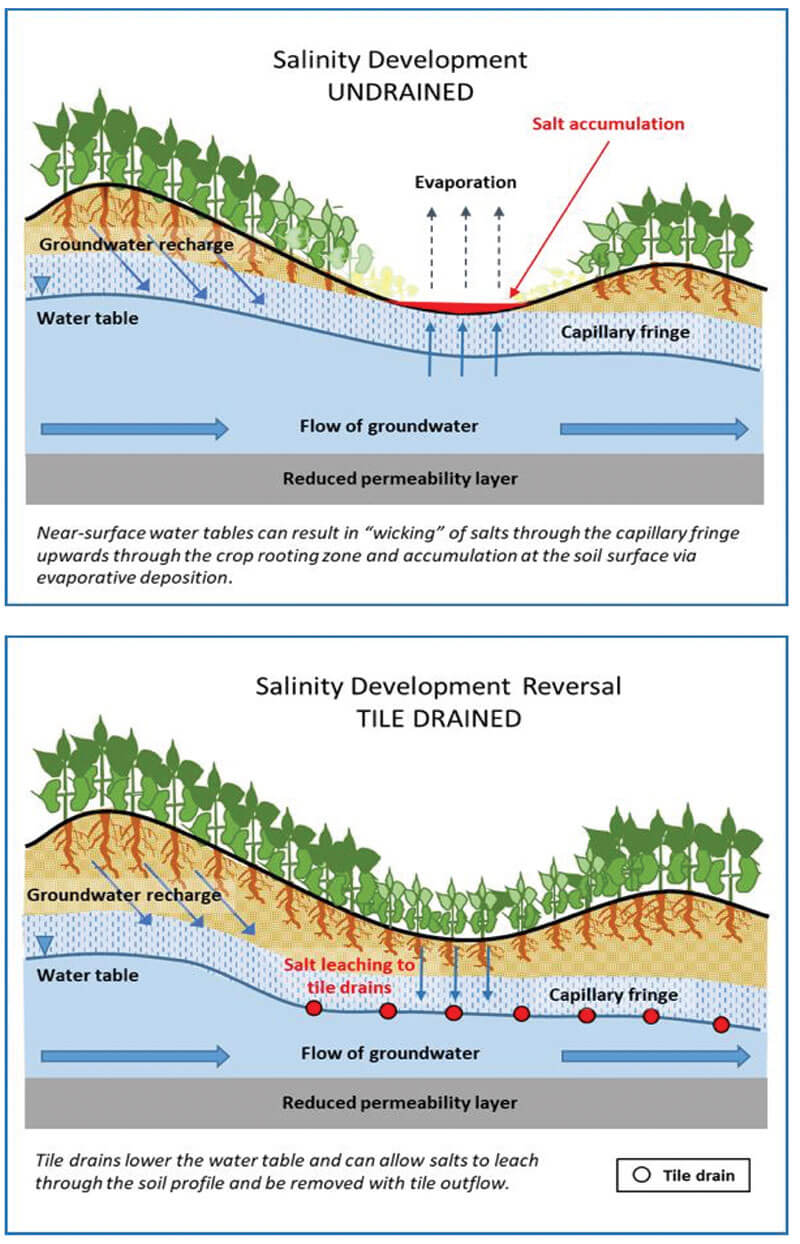Fix or set aside unprofitable acres?
Fix: Moving topsoil back to hilltops
MARLA RIEKMAN SAY NO TILL doesn’t immediately fix eroded areas like hilltops because plant growth is too low to significantly increase organic matter. An effective practice to improve productivity is to put the soil that has, over the years, eroded into low areas back to the hilltops where it came from. Then use no-till to keep it there.
Riekman, soil management specialist with Manitoba Agriculture, cites Manitoba studies showing that topsoil added to hilltops increases yields significantly, while having minimal effect on yield in low-lying areas where soil was removed (see graph). One project looking at the economics of soil-landscape restoration showed a return on investment within three to five years.
“This makes it the fastest ROI of any land management practice, including tile drainage,” Riekman says. “And that assumes the work was being done as a custom job. The ROI could be even faster if a farmer uses their own equipment and labour.”
Adding compost and manure to hilltops are also effective to increase productivity quickly, while other soil-building practices, like no-till, perennials, cover crops and increased fertilizer to increase crop biomass take longer to show results. “It took 10 thousand years to get soil to where it was in the first place. You can’t expect soil to fix itself over night with these other practices.”
Riekman says both quick and long-term soil health practices will lead to improved yield and fewer nutrient deficiency symptoms. Farmers will notice other benefits, she adds, including improved drainage, darker soil colour, higher organic matter and carbon content, and improved aggregate stability.


Fix: Strategic tile drainage
DAVID WHETTER, SOIL SCIENTIST and owner of AgriEarth Consulting, described the benefits of tile drainage to increase land productivity. He notes that before spending $1,000 to $1,500 per acre on tiles, farmers will want to look at surface drainage solutions first. “Tile drainage is complementary to surface drainage,” he says. Effective tile drainage also relies on a good municipal drainage system to move water out of the ditches. Otherwise, ditch water could possibly back up into the field through the tiles.
Tile drainage doesn’t necessarily have to cover the whole field. “I think that’s an important consideration,” says Jason Casselman, Canola Council of Canada agronomy specialist. “It may work that farmers can spend $1,000 per acre to fix the 10 acres that cause 90 per cent of their headaches.”
Tile drainage can reduce surface salinity and improve yield in saline areas. Damaging salinity occurs when the water table is at the soil surface and evaporation of this ground water deposits salts in the topsoil. Tile drainage lowers the water table to reduce the interaction between ground water and the soil surface. Over time, these salts are flushed out through the drains. Whetter quotes noted soil scientist Les Henry, who said, “The only real reclamation for saline soils is to remove excess water from the bottom and pour additional water on top to flush the salts out.” Tiles remove the excess water, but without irrigation to increase the flushing, it can take years to see an effective reduction in soil salinity, Whetter says.
The more immediate benefit is from rapid lowering of the water table. Tile drainage removes water that exceeds the holding capacity of the soil. This excess water impedes root function and limits field activities. By removing this water, tile drainage can improve plant health and plant uniformity and allow farmers to get on fields faster in the spring or after a big rain. In spring, tile drainage also improves infiltration of runoff once soils have thawed, and reduces peak overland flow which may reduce surface erosion and sediment loss from the field.
David Whetter collaborated with Bruce Shewfelt at PBS Water Engineering on tile drainage factsheets. Find them at pami.ca. Search for “Beneficial management practices for agricultural tile drainage in Manitoba.”
Tile drainage water can contain relatively high amounts of nitrogen, while phosphorus export is typically lower when compared to surface runoff losses. Whetter described a few best management practices to capture water or filter water before it leaves the field. For example, controlled-drainage valves can shut off the tiles after spring melt to stop flow through the growing season. Edge-of-field treatment options such as constructed wetlands can capture nutrients before runoff leaves the field, and collection ponds can provide water for irrigation later in the season.
Casselman knows a farmer in the Peace River region of Alberta who irrigated canola fields from dugouts using a drag line and gun sprinkler. “It was a drought year, and the farmer saw canola yields double in those areas irrigated with 1.5″ of water from the dugout,” Casselman says. Tile drainage systems that include retention ponds would improve field access and crop establishment in the spring while providing water for irrigation in mid-season.
Set aside: Convert unfixable acres to grass
MARK McCONNELL, ASSISTANT PROFESSOR and upland birds specialist at Mississippi State University, says 26 per cent of the agriculture land across 10 states from North Dakota to Ohio were classified as “stable low yield” in a recent study. These sub-field areas produce low yields, relative to the rest of the field, year after year. Farmers may not realize the magnitude of economic loss when those acres are annual-cropped. “Farmers know these areas are low yielding, but they may not know how much money they’re losing,” he says.
McConnell has field profit maps showing chronically unprofitable areas. Given the shape of these areas, it may not be practical to take them all out of production, but he says it can make sense to set aside some field edges.
Mark McConnell, assistant professor and upland birds specialist at Mississippi State University, calls bobwhite quail (below) the “canary on the prairie.” While he’d like more unprofitable areas returned to grass for the good of the birds, he knows that economics have to drive these decisions.
The keys, he notes, are to plant these areas to grass, not trees, and to keep them maintained. This came up during the Q&A at the end of the presentation. Someone asked whether returning field areas to conservation habitat would just push the issue farther into the field? McConnell cites papers showing that grasses and forages do not push problem areas further into the field, however one paper did show some issues when cropland was replaced with trees. Even with grass, which is the more natural prairie habitat, some maintenance is required. Farmers don’t want these areas to be kochia patches.
Programs are available to help farmers convert cropland to perennial habitat. Check with local grassland, watershed or conservation organizations.
McConnell has spent his entire career studying bobwhite quail, which he calls the “canary on the prairie.” If bobwhites are in trouble, this is a sign of bigger issues. While he’d like more unprofitable areas returned to grass for the good of the birds, he knows that economics have to drive these decisions.
In a published research paper, McConnell wrote: “I suggest targeted conservation be defined as the application of conservation practices only where they increase profitability to the producer.”
During the presentation, he added the following paraphrase: “If it doesn’t make money, it doesn’t make sense.”







